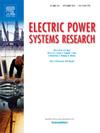一种基于在线聚类的最优分布式阻尼控制器设计
IF 3.3
3区 工程技术
Q2 ENGINEERING, ELECTRICAL & ELECTRONIC
引用次数: 0
摘要
低阻尼区域间低频振荡一直是互联电力系统面临的难题,导致了各种阻尼控制策略的发展。本文介绍了一种设计最优分布阻尼控制(ODDC)的新方法,以提高关键区域间模式的阻尼比,同时最小化通信链路,从而提高系统稳定性。结构约束的非凸特性增加了识别分布式框架中控制单元之间的最佳通信拓扑的复杂性。为了解决这一问题,采用一种计算效率高的半确定规划(SDP)松弛技术来解决非凸ODDC问题。此外,提出了一种基于广域测量数据的模式识别动态更新控制器系数的组合聚类框架,确保有效地阻尼区域间振荡。以MATLAB仿真的IEEE新英格兰39总线系统为验证平台,验证了ODDC方法的有效性。仿真结果表明,单通信链路的最优分布式配置大大提高了小信号稳定性。此外,当预先设计的控制器在不同的工作条件下失去有效性时,自适应更新模块成功地提供了新的系数来恢复足够的阻尼比。本文章由计算机程序翻译,如有差异,请以英文原文为准。
An online clustering-based optimal distributed damping controller design
Inter-area low-frequency oscillations with poor damping have long presented challenges in interconnected power systems, leading to the development of various damping control strategies. This paper introduces a novel method for designing Optimally Distributed Damping Control (ODDC) to enhance the damping ratios of critical inter-area modes while minimizing communication links, thereby increasing system stability. The non-convex nature of structural constraints adds complexity to identifying the optimal communication topology among control units in distributed frameworks. To address this, a computationally efficient Semi-Definite Programming (SDP) relaxation technique is applied to solve the non-convex ODDC problem. Additionally, a combined clustering framework is proposed to dynamically update controller coefficients based on mode identification using wide-area measurement data, ensuring effective damping of inter-area oscillations. The IEEE New England 39-bus system, simulated in MATLAB, serves as the validation platform, demonstrating the ODDC method’s effectiveness. Simulation results indicate that an optimal distributed configuration with a single communication link substantially enhances small-signal stability. Moreover, the adaptive updating module successfully provides new coefficients to restore adequate damping ratios when pre-designed controllers lose effectiveness under varying operating conditions.
求助全文
通过发布文献求助,成功后即可免费获取论文全文。
去求助
来源期刊

Electric Power Systems Research
工程技术-工程:电子与电气
CiteScore
7.50
自引率
17.90%
发文量
963
审稿时长
3.8 months
期刊介绍:
Electric Power Systems Research is an international medium for the publication of original papers concerned with the generation, transmission, distribution and utilization of electrical energy. The journal aims at presenting important results of work in this field, whether in the form of applied research, development of new procedures or components, orginal application of existing knowledge or new designapproaches. The scope of Electric Power Systems Research is broad, encompassing all aspects of electric power systems. The following list of topics is not intended to be exhaustive, but rather to indicate topics that fall within the journal purview.
• Generation techniques ranging from advances in conventional electromechanical methods, through nuclear power generation, to renewable energy generation.
• Transmission, spanning the broad area from UHV (ac and dc) to network operation and protection, line routing and design.
• Substation work: equipment design, protection and control systems.
• Distribution techniques, equipment development, and smart grids.
• The utilization area from energy efficiency to distributed load levelling techniques.
• Systems studies including control techniques, planning, optimization methods, stability, security assessment and insulation coordination.
 求助内容:
求助内容: 应助结果提醒方式:
应助结果提醒方式:


